
footwell access hatch complete, lots of pictures
FuryRebuild - 22/9/12 at 09:49 AM
Following on from this blog post about how I needed to change
my footwell configuration a bit (i.e. chop it all out and start again), I thought I'd share the access hatch design and fabrication with you.
Once I've got it all welded in (today's job) then more pics will follow.
First of all, this is the original Fury setup:

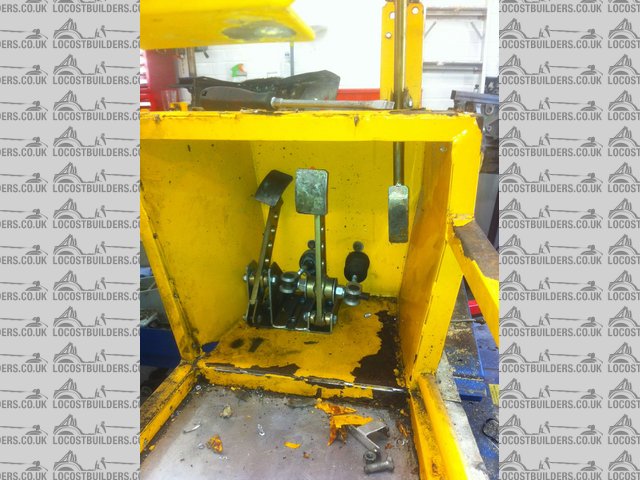
Description
And this is how it looks with the engine in place and the new bellhousing somewhat intruding, like a horny drunk at a funeral:
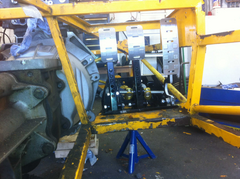

Description
Here things are with the new cross member in there, duratec still in place for reference:
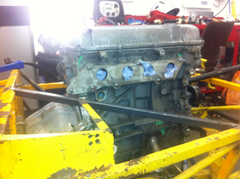

Description
And now everything's been cut away
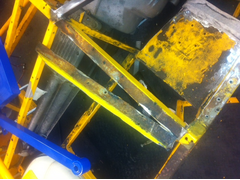

Description
New cardboard/hardboard formers made. Lots and lots of hot-glue and gaffer tape went into this.

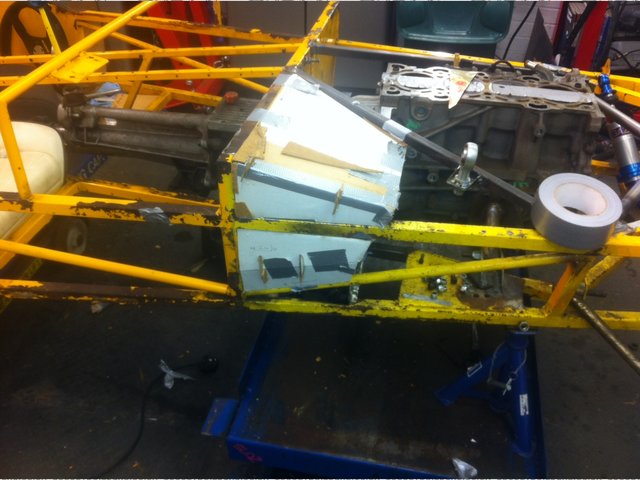
Description
which became this:
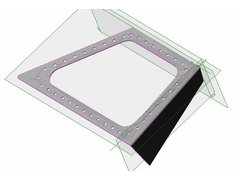

Description
which became this:

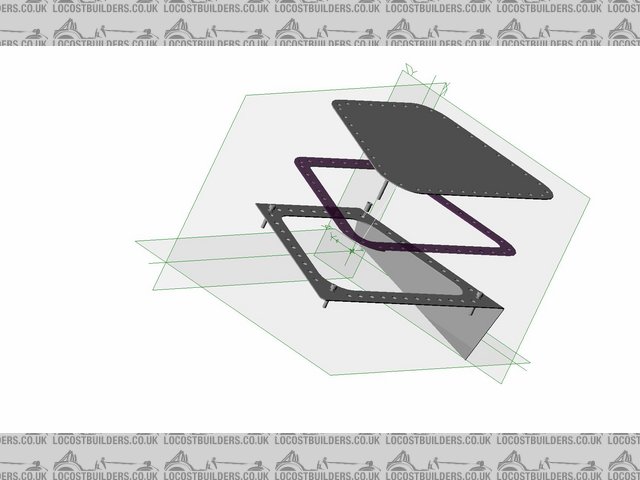
Description
Then the happy moment - the laser cutters gave birth to this:
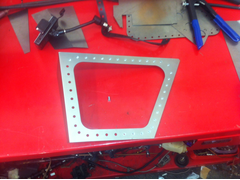

Description
and I added the nutserts so I didn't have to suffer lots of grief unbolting the top panel - this is meant to give easy access to the the
footwell, not make it worse:

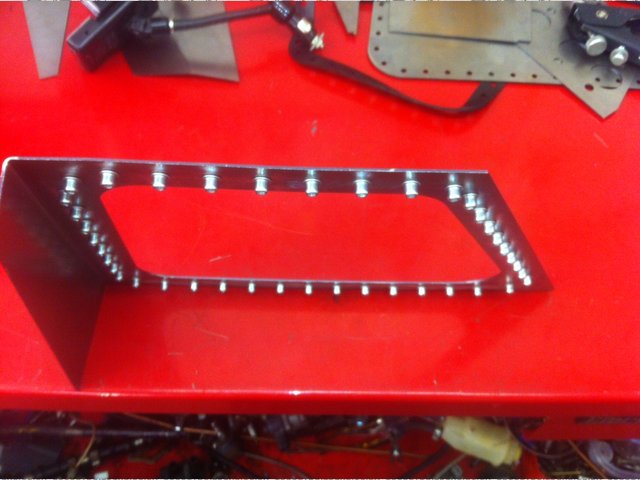
Description
here's the trial fit of the 3mm nitrile rubber gasket. The holes in the rubber are 1mm diameter greater than the holes the nutserts went into
(7mm) to allow for the slightly wider diameter of the nutsert - everything should fit flush
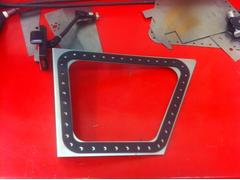

Description
Finally, the top panel is trial fitted

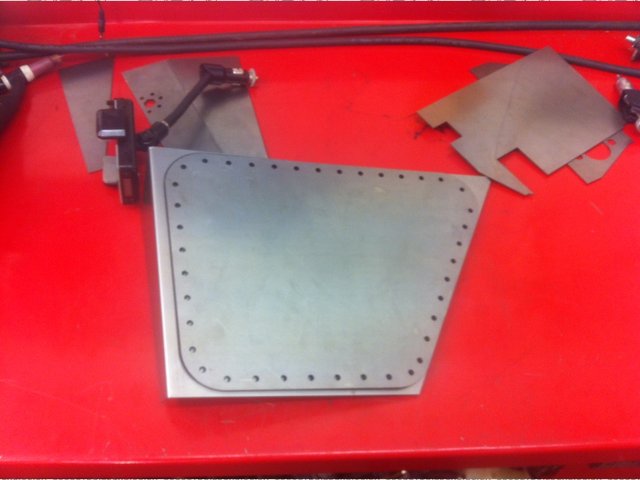
Description
and bolted 


Description
All that's left to do is to dissasemble, and tack weld each nutsert in place from the back - they can lose their grip and spin, rendering them
useless. A simple tack on the other hand makes them an excellent solution.
This is what they look like up close - they protrude 0.5mm so nearly flush
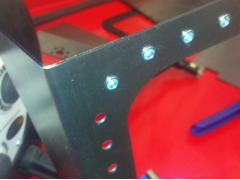

Description
[Edited on 22/9/12 by FuryRebuild]
HowardB - 22/9/12 at 09:56 AM
very impressive, clearly you own more than just a hammer!

FuryRebuild - 22/9/12 at 10:36 AM
Thanks Howard.
I choose to reply using a photograph:
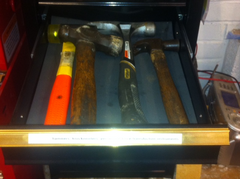

Description
The label on that drawer is "hammers, knockometers, percussive force transducers".
blakep82 - 22/9/12 at 10:39 AM
how many times do you think you'll use ALL of those rivnuts? 
bi22le - 22/9/12 at 11:22 AM
Looks very neat. I do agree. Little with Blake thinking that quick easy access is not undoing 50 dome head screws to get a panel off!
Nice execution though.
FuryRebuild - 22/9/12 at 11:24 AM
Well, there are a couple of aspects behind my decision to go hog wild with the nutserts:
1) getting down into the footwell is a pig when adjusting anything to do with the brakes or throttle cables, so having to get my arm in there to undo
anything on the back of the hatch will be nearly as bad as not bothering with the hatch, and will require two people to do it
2) lots of smaller (5mm) cap screws spreads the clamping force around better than larger ones, and the gaps between are about where the diameter of
the clamping force meets, hence getting something uniform
3) in the case of an impact I have a lot more bolts to spread the sheer force around, hopefully making it stronger
4) aesthetics
5) these 5mm cap screws match the length of the nutsert when tightened with the 3mm offset of the rubber gasket, so it's the minimum protrusion
into the footwell
omega 24 v6 - 22/9/12 at 11:24 AM
Nice but surely you must have shares in a rivnut company?



FuryRebuild - 22/9/12 at 11:25 AM
I buy them in bulk (50 off at a time - then they cost a tenner).
designer - 22/9/12 at 11:26 AM
Good work but, over-engineered, way too many fasteners. They don't use that many on planes.
FuryRebuild - 22/9/12 at 11:27 AM
Hi Bizzle.
With an electric or air screw-driver it is quick enough - 5 mins max. Access isn't for spot maintenance, but in case something serious needs
doing. I've worked in the fury footwell before and it's a good job I like caving. When you're lying on your back on the seat with your
legs in the air and your head in the footwell it can get a little claustrophobic.
I also have a remote bias adjuster so I shouldn't need to adjust down there very often, but even for fitting the pedal box and setting it up the
first time, the access hatch will have paid for itself.
FuryRebuild - 22/9/12 at 11:32 AM
Hi Designer
Porsche 962 - structural rivet gaps - 25mm with alternate interference rivets if you need them.
My spacings between cap screws - 25mm. I'm confident it's the right solution to get a structural panel connection.
designer - 22/9/12 at 11:57 AM
quote:
Porsche 962 - structural rivet gaps - 25mm with alternate interference rivets if you need them.
Agree, but they are structural!!
Access panel openings usually have a frame, or are swaged, and the panel held on by very few fastenings.
http://westfieldbec.weebly.com/build-diary.html
http://pitstopusa.com/i-5076707-allstar-performance-access-panel-kit-6-x-6.html
phelpsa - 22/9/12 at 12:00 PM
quote:
Originally posted by FuryRebuild
Hi Designer
Porsche 962 - structural rivet gaps - 25mm with alternate interference rivets if you need them.
My spacings between cap screws - 25mm. I'm confident it's the right solution to get a structural panel connection.
Maybe in 16 gauge ali, not necessarily in 14 gauge steel...
bi22le - 22/9/12 at 12:24 PM
Hey lets not beat furyrebuild down about this. Its his car and I think he can hear our opinions loud and clear.
He went down the effort of desinging and laser cutting the parts, im sure he thought hard about the amount of fixings used.
TheGiantTribble - 22/9/12 at 03:17 PM
I was impressed with the cardboard/hardboard bit
as for the rest
WOW well impressed
FuryRebuild - 22/9/12 at 03:43 PM
I've been fighting it a little since I posted this.
I've welded all the bazillion nutserts into place, and had a few of them have the weld leak a little onto the thread.
Turns out my m5*.8 tap is blunt. So, off to buy a new set.
Crap; it's a difficult job fabricating this, but the end result should be worth it. I tend to find the time invested in making something sensibly
demountable is always worth it.
to quote Douglas Adams: "the major difference between a thing that might go wrong and a thing that cannot possibly go wrong is that when a
thing that cannot possibly go wrong goes wrong, it usually tuens out impossible to get at or repair"
[Edited on 22/9/12 by FuryRebuild]
ashg - 22/9/12 at 05:47 PM
quote:
Originally posted by FuryRebuild
I buy them in bulk (50 off at a time - then they cost a tenner).
bulk? they come in boxes of 1000
i have got 8 m5 fixings holding the inspection plate on over the top of my pedal box and that is a pain in the ass to undo, hope you never have to
take it off at the side of the road if you balance bar or something moves down there.
FuryRebuild - 22/9/12 at 06:27 PM
We have a great motor factor in Harrogate who buys in quantities like that, then sells in lots of 100 (minimum spend). It means I never think about
reusing a locknut for instance.
Here is the top tacked in place, ready for the rest of the footwell to get tacked in.
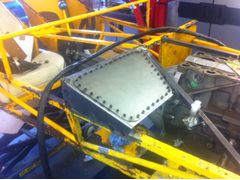

Description
Doctor Derek Doctors - 23/9/12 at 12:44 PM
quote:
Originally posted by FuryRebuild
2) lots of smaller (5mm) cap screws spreads the clamping force around better than larger ones, and the gaps between are about where the diameter of
the clamping force meets, hence getting something uniform
Your rivnuts sit proud of the plate so you have no clamping force between your two plates, you only have a clamping load between the cover plate and
the small amount of Rivnut that sits proud from the flange plate. If you want a clamping load you'll need to use nuts and bolts or rivets that
actually clamp the plates together.
You'd probably get a much better result using about 1/4 of the amount of nuts and bolts or rivets than all of those rivnuts.
Doctor Derek Doctors - 23/9/12 at 02:10 PM
Just noticed the gasket.... doh
ashg - 23/9/12 at 03:02 PM
quote:
Originally posted by ashg
quote:
Originally posted by FuryRebuild
I buy them in bulk (50 off at a time - then they cost a tenner).
bulk? they come in boxes of 1000
i have got 8 m5 fixings holding the inspection plate on over the top of my pedal box and that is a pain in the ass to undo, hope you never have to
take it off at the side of the road if you balance bar or something moves down there.
again i come back to my previous comment. 50 rivnuts for £10. your having your pants well and truely pulled down. a box of 1000 is only £15-20
even buying them in 50's from memfast is only £3 for 50 including posting them out in a stamped envelope
http://www.memfast.co.uk/shop/Vcat1.asp?cat=2251005045
RoadkillUK - 23/9/12 at 03:58 PM
This is ours, as you can see, that was in 2004 and it's fine still.
That means 2 things 
1) It's fine with only a few self tappers, and ...
2) I'm taking you to court Apple Style!
OK, admittedly yours shows a bit more quality, back to that Apple Style again 

40inches - 23/9/12 at 08:20 PM
I used 4 screws on mine, perhaps the MK chassis is stronger, so the panel doesn't need to be structural?

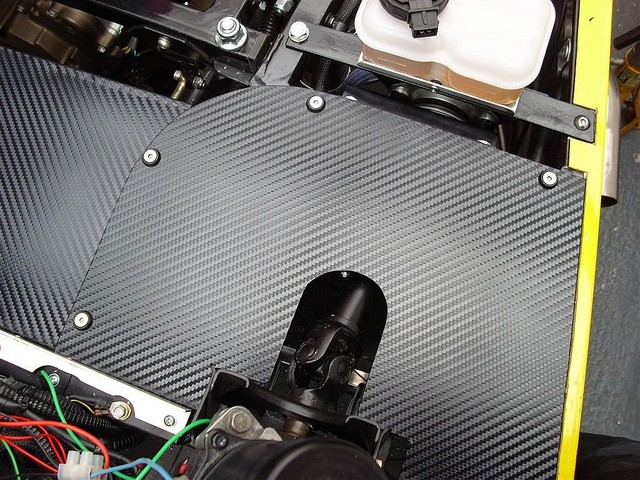
Carbon fibre2?
FuryRebuild - 23/9/12 at 08:29 PM
HI 40 inches
The fury chassis is already very strong (I've had one off on the track with it), but where my feet are concerned, I wanted it in a nice, strong
sealed box regardless. That's also why I've used nitrile rubber for the gasket; it's fuel proof and means I can maintain a full fluid
seal to the engine bay and it'll clamp down good and tight and never rattle.
The effort in doing all the holes in cad was about 30 minutes, and it took more time to align the parts to do an interference fit check than it did to
make the holes, panels, etc.
DavidW - 23/9/12 at 08:38 PM
quote:
Originally posted by 40inches
I used 4 screws on mine, perhaps the MK chassis is stronger, so the panel doesn't need to be structural?


Carbon fibre2?
Did you put something under that access panel to make it sit flat on the chassis?
I made my panel as one piece - once I'm I'm through IVA and into winter I'll be changing it. I'd rather have all those rivnuts
than the huge disassembly I have to face just adjust the pedals....
David
40inches - 23/9/12 at 08:41 PM
quote:
Originally posted by FuryRebuild
HI 40 inches
The fury chassis is already very strong (I've had one off on the track with it), but where my feet are concerned, I wanted it in a nice, strong
sealed box regardless. That's also why I've used nitrile rubber for the gasket; it's fuel proof and means I can maintain a full fluid
seal to the engine bay and it'll clamp down good and tight and never rattle.
The effort in doing all the holes in cad was about 30 minutes, and it took more time to align the parts to do an interference fit check than it did to
make the holes, panels, etc.
That sounds reasonable  The MK footwell is a welded steel box, so I suppose a light lid is acceptable.
The MK footwell is a welded steel box, so I suppose a light lid is acceptable.
FuryRebuild - 23/9/12 at 09:04 PM
Yeah - the original fury pedal box is 1.5mm folded and stitch welded. It's not a bad affair, but isn't compatible with a good pedal-box and
was designed for cable, not hydraulic clutch. Even after the pedal box, there isn't room for the duratec housing. Either way, it was coming out
and the new shape was necessarily more complex to handle the bellhousing and travel for the pedals.
Here's the top down view of it all tacked in place. You can just see the throttle pedal poking through ready to get a little box made for it.
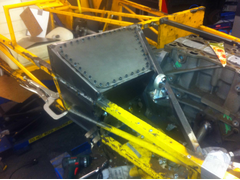

Description
Here's the view ready for the brake cylinders to go in. I only had one bolt-hole with a missmatch, and it needed opening out by 1mm.
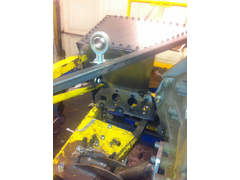

Description
All that remains is to put the complex transmission tunnel panel in, but that will require taking the engine off its mounts and moving it over a
little. No hassle doing this.
Once complete, the engine and box can come out so everything can be seam welded.
I deliberately made the side panel in several pieces to be welded to the cross members. The main reason for this was to be sure the sand-blaster and
powder-coater could get in there and no panel remained exposed.
FuryRebuild - 23/9/12 at 09:07 PM
Roadkill
My panel is round, yours is square. I used nutserts. I think we're fine for patent battles.
40inches - 23/9/12 at 09:16 PM
That will look the biz when it's all powder coated. Good feeling when a plan comes together, isn't it?
loggyboy - 24/9/12 at 01:25 PM
Was the gasket cut out of a large sheet or a carefully placed 1inch wide roll?
FuryRebuild - 24/9/12 at 01:30 PM
Hi loggyboy
It's 3mm fuel resistant nitrile, water jet cut to my pattern. It was the most expensive part and I also bought a spare.
loggyboy - 24/9/12 at 01:36 PM
quote:
Originally posted by FuryRebuild
It was the most expensive part and I also bought a spare.
Thats all i need to know, i'l stick with the plan to use this for my pedal box seal! NEOPRENE RUBBER SELF ADHESIVE STRIP 25mm
x 3mm X 10MTR | eBay
FuryRebuild - 24/9/12 at 01:47 PM
That's a good choice.
I wanted to be sure I was protected from the fuel, but at the same time that was the stock rubber my engineering shop carried. The gaskets were £25
each! Needless to say the costs come down considerably when ordering in bulk
nick205 - 25/9/12 at 06:11 PM
I like the detail and execution of the design myself. I've been following your rebuild for a while and like the attention to detail you're
applying. Should be a very tidy car when completed and very satisfying too.
JonT - 25/9/12 at 06:28 PM
Holy moly, that's a recipe for RSI 
I also have just four bolts on the cover over my Striker footwell. Definitely agree it's VERY handy to have...there are just sometimes some jobs
where you don't want to be hanging upside down in the footwell with your feet dangling over the rollbar...been there before!
mcerd1 - 27/9/12 at 12:39 PM
personally I think its a bit OTT but very nicely executed 
but then plenty of folk on this site have gone way OTT on at least one part of there cars….
I don't even want to admit how much time, effort and cash have gone into some bits of my car - and mine doesn't even look like a car yet !
FuryRebuild - 27/9/12 at 02:30 PM
Hi Mcerd1
It was a pain when I originally built the car, so I wanted to do something very different.
Designing the parts for the top and hatch, gasket etc. wasn't too much effort; probably three hours all in. The footwell needed replacing anyway
to accommodate the pedal box. Of the 3 hours, maybe an extra 30 minutes went into the extra design of the hatch.
It takes about 5 mins to screw all the cap-screws into place with a good electric screw driver; not a major hassle for something I never intended to
be an on-again, off again part.
You're right - we all tend to obsess about some things. I wanted the pedal box to remain very strong even with a gurt hole cut in the top, rather
than lose it's structural integrity.
It's taken a lot of time to seam weld it all in place (rather than stitch) but I'm nearly there now. Once it's powder coated,
it'll look the muts. I remember watching an episode of top gear where St Jeremy got the bonnet up on a Alfa 3.0 156 and pointed out that the
exhuast manifold pipes were chromed. Unnecessary but great. I think I've engineered my bits a bit the same, but I was working to my own spec of
"lots of access, lots of strength, no rattles, reliable fluid seal in the bulkhead area".
Of all the panels I designed and had made, this is my favourite. It gives the clearance around the bellhousing at the same time as enough clearance
with the clutch pedal. It was bent up from flat, and when bent properly, the slit is less than 0.5mm wide.
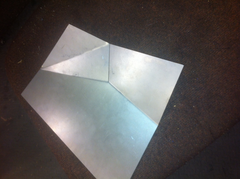

Description
mcerd1 - 27/9/12 at 03:10 PM
I feel a new thread coming on here 
quote:
Originally posted by FuryRebuildI think I've engineered my bits a bit the same, but I was working to my own spec of "lots of
access, lots of strength, no rattles, reliable fluid seal in the bulkhead area".
Sound like my plan for this area on my dax, although strength should be much less of an issue (the dax chassis is quite different)
quote:
Originally posted by FuryRebuild
Of all the panels I designed and had made, this is my favourite. It gives the clearance around the bellhousing at the same time as enough clearance
with the clutch pedal. It was bent up from flat, and when bent properly, the slit is less than 0.5mm wide.


Description
I take it you had that waterjet/laser cut too ?
for the most part I'll end up just using my dads guillotine and box pan folder with some thin alloy sheet, not quite as fancy but it should make
a neat enough job 
FuryRebuild - 27/9/12 at 03:47 PM
Yes - that was laser cut and put through the robot press brake.
I think you'd get very good results that way - I happened to have good CAD software and went down that route but it did feel like evenings
working on the CAD weren't getting my hands dirty but now it feels like good time invested. there were only a couple of parts that didn't
fit perfectly, and a little adjustment did the job.
FuryRebuild - 29/9/12 at 04:45 PM
time to undo the panel using an electric screw-driver: 2:50. Not a major ball-ache.
Furyous - 29/9/12 at 08:00 PM
That's less time than it took me to get the 8 screws off my access panel after finding the cap heads had rounded off and none of my allen keys
fit.
What about when you have the steering rack and other things in the way?
[Edited on 29/9/12 by Furyous]
DIY Si - 1/10/12 at 09:01 PM
More importantly, how long when the screw driver's flat, it's dark and the throttle cable's snapped? 
Note, I've only ever had to do this to mine in the day light. But the MK roll bar is just the right height for my feet to rest on! Although it
did give the police officer pause when they came to see what the problem was.
Although it
did give the police officer pause when they came to see what the problem was.





















 Although it
did give the police officer pause when they came to see what the problem was.
Although it
did give the police officer pause when they came to see what the problem was.